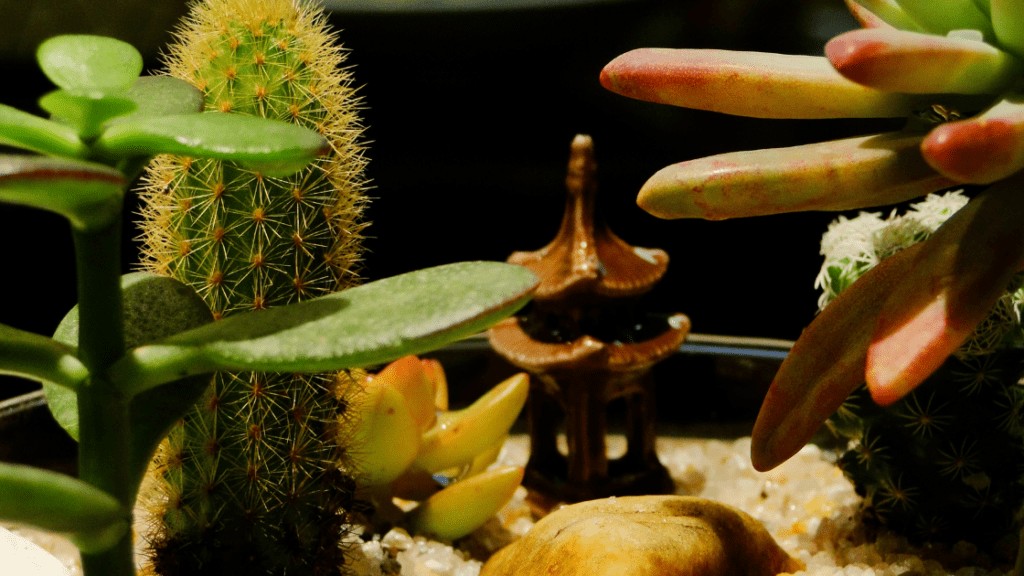
The fairy castle cactus is a very popular indoor cactus – it grows very well when placed on a windowsill and it doesn’t require much care. It has a typical ‘cactus-like’ look and has a very attractive structure, consisting of many separate, vertical stems.
This cactus grows relatively well in poorly lit areas, making it perfect for the indoors and it can be easily propagated by stem cuttings. In this article, we’ll further explore the origin of this cactus, its optimal growing conditions and will give you all the information you need in order to successfully take care of it for years or even decades to come!
What Is A Fairy Castle Cactus?
The fairy castle cactus belongs to the Acanthocereus tetragonus genus. It has a controversial taxonomy and there is no agreement as to whether or not this cactus is a single, specific variety or a collection of a small number of sub-species.
Browse our Affiliate Products
It’s native to both South and North America and is widely distributed throughout both continents, with different varieties displaying slightly different characteristics and sizes. However, it’s not clear whether the differences observed are caused by different genetics, or by different growing conditions like daylight length and temperature.
Either way, the cactus is easy enough to recognize by its large number of unevenly dividing stems having a plus-sign shaped cross section.
Why Is It Called a ‘Fairy Castle’?

The name of this succulent is pretty self-descriptive – with its large number of stems that grow in parallel, its structure tends to look like many of the fairly castle drawings you see in children’s books.
The cactus slowly spreads horizontally on the surface of the soil and eventually, the whole surface of the potting container gets obscured by the numerous cactus stems.
How Big Does It Get and How Quickly Does It Grow?
The Acanthocereus genus to which this cactus belongs to contains several very large species, the largest of which can reach 23 feet in height! The fairy castle sub-species can still get pretty large and reach up to 6 feet in height.
However, it’s usually grown in small pots placed on a windowsill, in which case it rarely reaches more than 1 foot in height. It’s a very slow growing cactus that can take 10 years to reach maturity and start flowering.
Optimal Growth Conditions For The Fairy Castle Cactus
The fairy castle cactus is a very undemanding succulent – like most other cactuses it simply requires a well-draining soil, plenty of sunlight and infrequent watering. It’s also relatively easy to propagate, because it has a large number of stems which can be easily removed and rooted in a separate container.
Let’s take a closer look at the optimal growing conditions:
Does It Grow Best Indoors or Outdoors?
This cactus grows well both indoors and outdoors, but it’s best to keep it in a potting container and not plant it directly in your garden. unless you live in a USDA zone above 9 or 10 and can provide some shading during the summer.
If your wondering what zone you are in click here, or find a zone similar to your area. Planthardiness.ars.usda.gov/PHZMWeb/
Any time the temperature drops below freezing (30F or 1C) there is some risk of frost damage, although varieties sourced from the North American wild can certainly deal with some light frost. Fairy castle succulents are almost always grown indoors in small pots and do very well when placed on a windowsill.
Placing the potted cactuses outside in direct sunlight during the summer doesn’t really give them a huge growth advantage and they will grow very slowly regardless of how much sun you give them.
How Much Sun Does a Fairy Castle Cactus Need?
Although in its natural habitat it often grows in direct sunlight, it’s best to provide some partial shading for this cactus.
For more information about shading Click on our link to read more. Outdoorgardenaccessories.com/shade-cloth-vs-blinds-which-is-better-for-patio-plants/
A potted cactus that is used to growing indoors doesn’t posses a deep enough root system and a thick enough outer layer and may start losing too much water if suddenly stressed by the scorching rays of the full sun.
Although it can be slowly acclimatized to survive well in direct sunlight, this process may take as long as a year.
What Type of Soil Is Required?
Fairy castle succulents grow well in all cactus potting mixes – they require a well-draining soil but don’t demand a lot of nitrogen. They can survive in very poor, sandy soils in which case they will grow very slowly. As we’ll discuss later, different soil mixes require different watering frequencies.
As with all plants each need a recommended soil structure. To read more about soil, click here. Outdoorgardenaccessories.com/what-are-the-best-potting-soils-for-every-type-of-plant/
Is Fertilization/Feeding Recommended And How Often Should You Do it?
Just like most succulents, this cactus grows the fastest when it’s fertilized with a cactus fertilizer each spring. It’s important to note that abundant or prolonged fertilization will not increase the growth rate of the cactus and will only lead to problems.
Fertilizing too many subsequent times with a high-nitrogen fertilizer will lead to nitrogen buildup in the soil, which can cause problems with the roots and can even kill the succulent.
A balanced, low-nitrogen fertilizer is recommended – 5-10-10 works well. Watering the cactus with a diluted, 25% strength cactus fertilizer 2-3 times during the spring usually works best. If you suspect you’ve over-fertilized the succulent, do a flush with regular water, which will wash off most of the accumulated fertilizer.
How Often Should You Water It?
As a general rule, you should water your fairy castle cactus only when the soil has completely dried up. The exact watering frequency depends on the size of the cactus, the volume of the potting container and the type of soil used.
For tiny pots, weekly watering may be necessary, For larger containers, watering once per month is usually ideal. As is the case with most succulents, over-watering can lead to more problems than forgetting to water.
The cactus can survive months of no watering, in which case it will start shriveling or wilting. Once watering is resumed, it usually recovers very quickly. Soil mixes that are very fine or contain a lot of perlite may require less frequent watering.
Is The Fairy Castle Cactus Easy to Propagate?
The fairy castle cactus is very easy to propagate. As is the case with most succulents, it may take a long time for the cuttings to develop roots.
The structure of the cactus allows you to easily take a large number of cuttings, sometimes without even using a knife. The propagation procedure simply involves taking a cutting and sticking it in some cactus potting soil or some sand.
It’s best to let the cutting dry out for a bit before planting it. This allows the surface of the cut to form a protective layer of dead cells, greatly reducing the chance of rotting problems. The cutting should be watered just like a full-grown cactus and you should always let the soil dry out before watering again.
Combining It With Other Succulents

Because this cactus likes to spread horizontally by developing multiple branches and stems, it’s best to plant it in its own container that doesn’t contain other succulents.
Eventually, it will colonize the whole surface of the pot. Another important consideration is that the fairy castle cactus doesn’t like direct sunlight, which makes it somewhat incompatible with many other sun-loving cactuses, like the popular Echinocactus.
Is The Fairy Castle Cactus Poisonous?
The cactus is not considered toxic to humans or animals, but this hasn’t been thoroughly verified. Regardless, its spines defend it well from pets, making it extremely unlikely that any animal will try to consume it.
Coming into contact with cactus juices while taking a cutting is completely harmless. Obviously, you shouldn’t experiment with consuming the tissue of the succulent – although non-toxic, it’s definitely not an edible plant.
When Does It Bloom?

The fairy castle cactus is not considered a flowering succulent – it blooms rarely and unpredictably.
Grown from seed, the cactus takes up to 10 years before it starts flowering. However, because most fairy castle cactuses are propagated perpetually from cuttings, which preserves the age of the plant, most purchased succulents are already mature and can flower.
There isn’t a reliable way to make this cactus bloom – it photosynthesizes slowly, accumulating sugars in its body. When it senses that it has enough nutrients and the conditions are right, it will put out a single flower that will be very short-lived.
The flower will open up at night, waiting to be pollinated and will die shortly after that.
What To Do If The Cactus Blooms?
If your cactus starts flowering, consider yourself lucky – this is a rare occurrence and means that you’ve provided the succulent with perfect growing conditions.
There is nothing you have to do if the cactus flowers – the flower will open up at night and will die soon after. Increasing the humidity and placing the cactus in a more shaded area can preserve the flower for longer, but it will still be very short-lived.
Pollinating the flower and attempting to germinate the resulting seeds can be an interesting undertaking for more advanced succulent growers.
Common Problems You May Encounter When Growing This Cactus
Unlike other succulents that may easily get infested by mealybugs or other insects, the fairy castle cactus is not really susceptible to insect infestations.
Almost all of the problems you may experience will be a result of over-watering, over-fertilization or insufficient light.
Over-watering
Almost all of the problems you can experience while growing a fairy castle cactus will come down to over-watering.
The main symptoms you should watch out for are wilting and shriveling. Watering too frequently without letting the soil dry out a bit can suffocate the roots and prevent them from properly absorbing water.
This is a very easy to misdiagnose problem – the more you water, the more the cactus will wilt and display signs of dehydration. Eventually, root rot may set in, completely killing the plant.
This is why it’s best to experimentally determine the optimum watering frequency by gauging the surface humidity of the soil – water only when the surface has gone completely dry.
Final Thoughts
The fairy castle cactus is one of the best windowsill succulents – it doesn’t require direct sunlight and can survive fine even when placed on a desk indoors. It is very easily propagated from cuttings, making it perfect for succulent lovers who like to experiment.
This cactus is very easy to care for and the only easy way to accidentally kill it is by watering it too frequently, allowing for bacterial root rot to set in.










